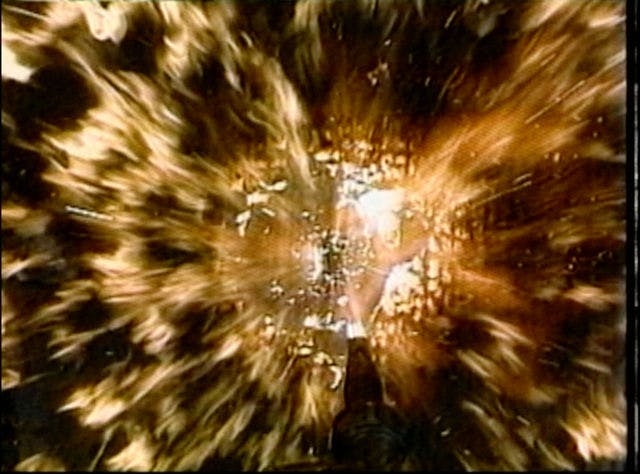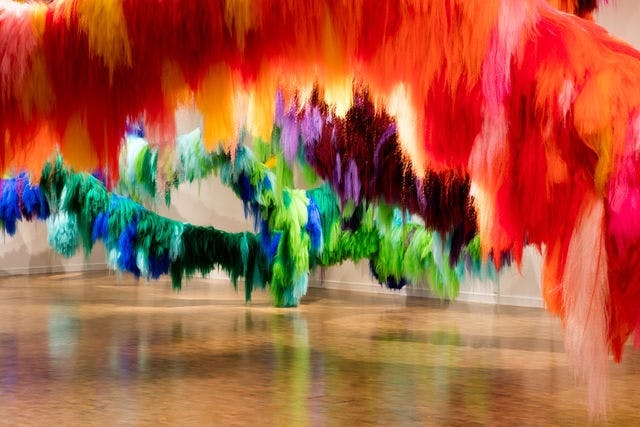Pyroglyphs
Steina
13.4.2017 — 20.8.2017

13.4.2017 — 20.8.2017
Video Environment
Steina
Steina's Collaborators
Tom Joyce and Zach Poff
STEINA
Steina (Steinunn Briem Bjarnadóttir Vasulka, b. 1940) is an Icelandic visual artist, and an international pioneer of video art. She started her career as a violinist, studying in Prague in 1959–1964. There she met her husband to be, Woody Vasulka (b. 1937), an engineer and filmmaker, and together they moved to New York in 1965. Discovering the new handheld Sony Portapak in 1969, they worked together on the emerging medium of video.
In 1971, they founded the world's first multimedia centre, The Kitchen, in New York, and in 1973 they became faculty members at the first media department at the State University of New York in Buffalo, NY. Steina and Woody are regarded as critically important experimental artists and pioneers of video art. Over the years, they have built their own equipment, robots and machines and their work has influenced much of the development of video art itself.
From screens to recording, and from documentary processes to highly complicated experimental works, they have indeed transformed and re-invented themselves as artists, and still do.
Steina's work has been exhibited at major museums and festivals around the world, including the Whitney Museum and the Brooklyn Museum in New York, the Centre Georges Pompidou in Paris, Berlin Film Festival, Ars Electronica in Linz and The Institute of Contemporary Art
in Boston.
Steina became a Guggenheim Fellow in 1976, and in 1997 she represented Iceland at the Biennale di Venezia. In 2015 Steina was awarded The Order of the Falcon in Iceland and in 2016 she was granted an honorarium artist salary from the Icelandic government.
PYROGLYPHS 1994
A Video Environment by Steina In Collaboration with Tom Joyce The initial inspiration for Pyroglyphs was the ancient art of blacksmithing but it soon became a musical treatise . . . In Steina's words: “In 1994 I spent long hours with blacksmith Tom Joyce, videotaping the process of building an iron gate. I found iron gates a little too concrete, so I closed in on the intense and violent nature of materials being manipulated by torches, files, and anvils—the rapid flicker of flames . . . Tom and I share a fascination with fire — as a phenomenon and as a medium of transmutation.”
Steina videotaped, mostly in closeup, the activities of blacksmithing (hammering, filing, welding, manipulating fire), the phenomenology of fire (flames, sparks, combustions, glowing metals), and various improvised scenes — a vise crushing timber, a stack of books burning, paper and wood being scorched.
Editing this material into three complementary image tracks was relatively easy (the visuals were similar or dissimilar in compatible ways) but the sounds of those images were often too similar or too strident, competing for attention. So the sounds determined the editing. Steina processed them through digital devices like harmonizers, which couldn't turn the random noises into harmonics but produced interesting sounds anyway; pitch shifters that move a sound to intervals immediately above or below; and reverb circuits to create echo effects. The sounds and rhythms are rendered allegro con brio, pianoforte, or pianissimo: there is a lot of percussive hammering, say, then all is quiet and we hear only crackling flame or the hollow whisper of the blowtorch . . .
PYROGLYPHS is a spectacular meditation on fire. Steina has created a sublime landscape illumined by the many-hued glow of fevered metals and showers of sparkling scintilla. She makes us feel the hypnotic pull of lambent flames even as our breath is caught by the pre-emptive ignition of the torch, our hearts quickened by the violence of the forge.
Pyroglyphs is presented for the first time in Iceland.



